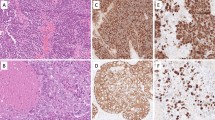Synopsis
The carbohydrate-rich compounds in bronchopulmonary neoplasms and in non-neoplastic tissue have been characterized histochemically. Glycogen was present in few epidermoid and large-cell carcinomas. Epithelial mucosubstances were produced by adeno-, mucoepidermoid, and large-cell carcinomas. The mucosubstances produced by carcinoma cells had characteristics different from those occurring in normal tissue. The most striking characteristic was the presence of a sialidase-labile compound in certain neoplasms.
Hyaluronic acid was present in the stroma of the carcinomas. In a third of the cases studied, chondroitin sulphates were also present. Higher sulphated compounds were observed as well. This stromal reaction was correlated with the occurrence of a round cell reaction, but not with mast cells. This was considered to indicate the production of stromal material and fibres, but it can also explain the high levels of carbohydrate-rich substances in serum and urine in cases where neoplastic tissue itself does not produce such substances. It also agrees with the theory of carbohydrate-rich compounds acting as a ‘barrier’ preventing immunological reactions against neoplastic cells.
Similar content being viewed by others
References
Barka, T. &Anderson, P. J. (1965).Histochemistry, Theory, Practice, and Bibliography. New York: Hoeber Med. Div., Harper & Row.
Boström, H., Friberg, U., Odeblad, E. &Ringertz, N. (1954). Uptake of labelled sulphate by expermental skin tumours in the rat and the mouse.Acta path. microbiol. scand. 35, 1–7.
Cramer, W. &Simpson, W. L. (1944). Mast cells in experimental skin carcinogenesis.Cancer Res. 4, 601–16.
Currie, G. A. &Bagshawe, K. D. (1967). The masking of antigens on trophoblast and cancer cells.Lancet ii, 708–10.
Evans, R. W. (1966).Histological Appearances of the Tumours (pp. 1096–8). London: E. & S. Livingstone Ltd.
Hieronymi, G. (1954). Über Vorkommen und Verteilung saurer Mucopolysaccharide in Geschwülsten.Frank. Z. Path. 65, 409–34.
Kirby, D. R. &Wood, C. (1967). Embryos and antigens.Sci. J. 3, 56–60.
Kiriluk, L. B., Kremer, A. J. &Glick, D. (1950). Mucolytic enzyme systems XII Hyaluronidase in human and animal tumors, and further studies on the serum hyaluronidase inhibitor in human cancer.J. natn. Cancer Inst. 10, 993–1000.
Kizer, D. E. &Mccoy, T. A. (1959). The synthesis of hexosamine in tumor homogenates.Cancer Res. 19, 307–10.
Kolăr, V. &Kadlecová, D. (1967). Serum mucoproteins in malignant tumorous diseases.Neoplasma 14, 79–82.
Korhonen, L. K. (1967). Specific methylation of carboxyl groups by thionyl chloride in methanol.Acta histochem. 26, 80–2.
korhonen, l. k., holopainen, e. & paavolainen, m. (1968). Some histochemical characteristics of tracheobronchial tree and pulmonary neoplasms.Acta histochem. (in press).
Kreyberg, L. (1962). Histological lung cancer types. A morphological and biological correlation.Acta path. microbiol. scand (Suppl.)157, 1–92.
Kreyberg, L., Liebow, A. A. &Uehlinger, E. A. (1967). Histological typing of lung tumours.International Histological Classification of Tumours No. 1. Geneva: World Health Organization.
Luke, J. L. &Spicer, S. S. (1966). Histochemistry of surface epithelial and pleural mucins in mammalian lung.Lab. Invest. 14, 2101–9.
Pearse, A. G. E. (1960).Histochemistry: Theoretical and Applied. 2nd Ed., pp. 228–280. London: Churchill.
Scott, J. E. &Dorling, J. (1965). Differential staining of acid glycosaminoglycans (mucopolysaccharides) by alcian blue in salt solutions.Histochemie 5, 211–33.
Seibert, F. S., Seibert, M. V., Alno, A. J. &Campbell, H. W. (1947). Variation in protein and polysaccharide content of sera in the chronic diseases, tuberculosis, sarcoidosis, and carcinoma.J. clin. Invest. 26, 90–102.
Shetlar, M. R., Kelly, K. H., Foster, J. V., Shetlar, C. L. &Everett, M. R. (1950). Serum polysaccharide levels in pregnancy, parturition, and the postpartum state.Am. J. Obstet. & Gynec. 59, 1140–5.
Spicer, S. S. (1960). A correlative study of the histochemical properties of rodent acid mucopolysaccharides.J. Histochem. Cytochem. 8, 18–23.
Spicer, S. S., Horn, R. G. &Leppi, T. J. (1967). Histochemistry of connective tissue mucopolysaccharides. In:The Connective Tissue (ed. B. W. Wagner & D. E. Smith), pp. 251–303. Baltimore: Williams & Wilkins Co.
Sylven, B. (1945). Ester sulphuric acids of high molecular weight and mast cells in mesenchymal tumours.Acta radiol. (Suppl.)59, 1–99.
Willis, R. A. (1952).The Spread of Tumours in the Human Body. 2nd Ed, p. 118. London: Churchill.
Winzler, R. J. (1955). Determination of serum glycoproteins. In:Methods of Biochemical Analysis (ed. D. Glick), pp. 279–311. New York: Interscience Publishers.
Author information
Authors and Affiliations
Rights and permissions
About this article
Cite this article
Korhonen, L.K., Mäkelä, V. Carbohydrate-rich tissue components in lung cancer and in normal bronchial tissues: a histochemical study. Histochem J 1, 124–140 (1968). https://doi.org/10.1007/BF01002583
Received:
Issue Date:
DOI: https://doi.org/10.1007/BF01002583




